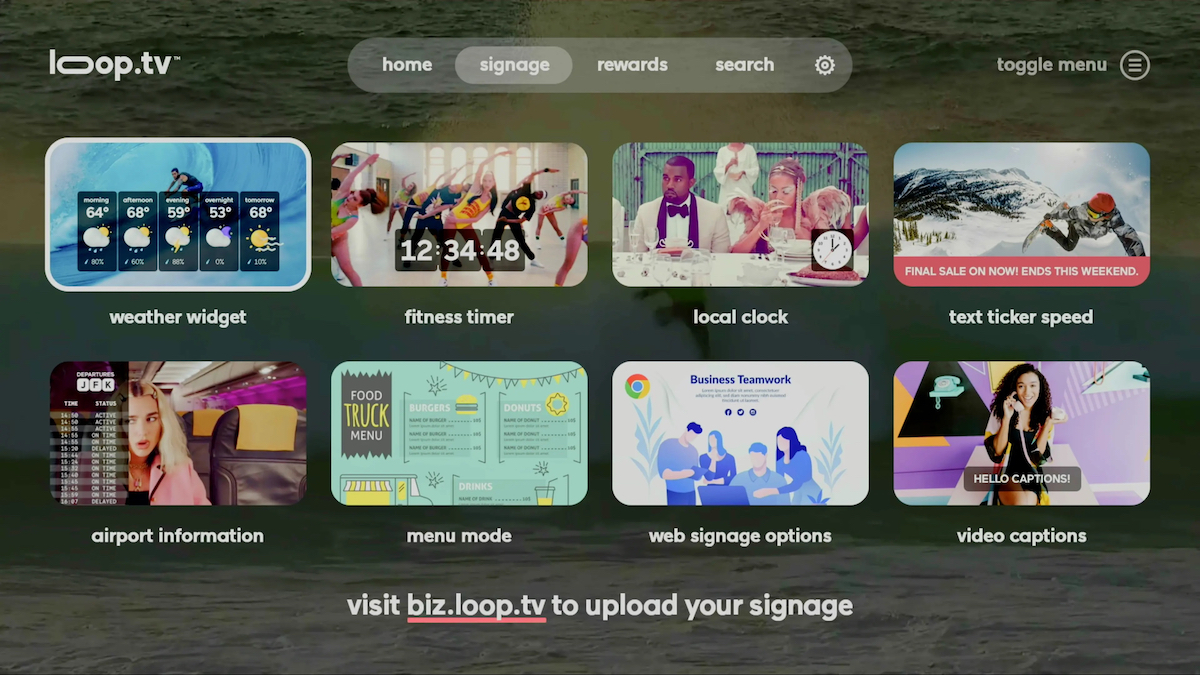
Loop TV Buffs Up UX As It Chases On-Premise DOOH Business Model
August 22, 2022 by Dave Haynes
One of the reasons I’ve discouraged digital signage CMS software companies from making small to medium restaurants and retail operations a primary vertical is that they are going to be dealing with a lot of competitors chasing the same finite, tight-budget business, including competitors who are putting in digital signage capabilities for free.
It’s a model that’s been around for as long as digital signage and digital out of home got names that people kinda-sorta/mostly agreed on. It feels like that “we-put-it-in-free, you-get-a-revenue-share” model kind of went away for a few years, as end-users didn’t see the revenue share returns that were promised and because the screens in their venues offered little or no messaging that would benefit their bottom lines.
But the model seems to have come back, as over the top (OTT) streaming service capabilities have matured and things like smart TVs and low-cost, reliable set top boxes have lowered the cost and complexity of deployments. Web-based software advances have also enabled venue operators to easily incorporate local messages, even menus, in their hyperlocal version of service.
LA-based Loop Media is one of those companies with a free model based on advertising revenues. It is competing for the same markets and screen spaces as Austin’s Atmosphere TV, and has recently announced software upgrades to its user experience, adopting a look and feel familiar to people who ruse services like Netflix.
“The Loop Player’s new interface is the plug-and-play, turnkey gateway to 145+ channels of music and non-music channels optimized for consumption in the Digital Out Of Home (DOOH) environment,” says the company in PR. “The new user experience brings an image-based layout of icons popular with leading consumer streaming services and is more intuitive and streamlined when it comes to navigation and search. Highly requested features such as on-screen widget controls, video restrictions, and channel overviews have been added, while the new search functionality easily highlights channels for every business type and scenario.”
“Customer feedback and research has us constantly innovating and evolving to make our service easier and more powerful for businesses using the Loop Player for streaming video and digital signage,” says CEO and Co-Founder Jon Niermann. “This new interface will make it much easier for our clients to find and present content that is best for their business and their customers.”
Loop Media says it has a footprint in all 50 US states, and by the end of Q2 2022 had about 12,600 end-points in the field. It also has a partnership with GSTV at gas station pumps and the company says it is in “400,000 hotel rooms in over 1,300 hotels in the US” with a service, I assume, is on-demand and bulks up what can be pretty skimpy in-room TV offerings.
The company has grown its footprint by about 4,000 this year, but is operating now with a pretty big, dark financial cloud drifting overhead. The latest SEC filing says: “For the nine months ended June 30, 2022, we had a net loss of $(14,921,110), had net cash used in operating activities of $(8,832,956), had working capital of $(1,565,517), and an accumulated deficit of $(81,763,526). These matters raise substantial doubt about our ability to continue as a going concern for a period of one year from the date of this filing.”
$81M is in Wireless Ronin territory in terms of accumulated deficit.
Loop is fueled by one of the largest and most important libraries that includes music videos, movie trailers and live performances. Loop Media’s non-music channels cover a multitude of genres and moods and include movie trailers, sports highlights, lifestyle and travel videos, viral videos and more. Loop Media’s streaming services generate revenue from advertising, sponsorships, integrated marketing and branded content from free-ad-supported-television (“FAST”) and from subscription offerings.
The company’s most direct competitor (I think) is Atmosphere, which has about 60 curated content channels and runs a network of Apple TV set-top boxes in some 30,000 locations in and outside the US.
There’s also UpShow, which is taking a different path in chasing the same market. The Chicago company is marketing paid content management capabilities for both front and back of house, as well as a library of 100s of over-the-top streaming entertainment channels.
And then there are big companies like Samsung that have “prosumer” Smart TVs tied to a smartphone app, to allow low-cost, simple digital signage messaging in bars, restaurants, salons and elsewhere.
Not an easy vertical to chase and make money from …




Leave a comment